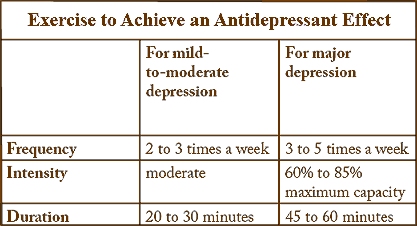|
About
Postpartum Care
Exercise as a
Treatment for Depression in New Mothers:
It’s as
Effective as Medications
Kathleen Kendall-Tackett, Ph.D., IBCLC
A growing body of research indicates that exercise is an effective
treatment for depression and is comparable medications.
Traditionally, exercise has been recommended for people with
mild-to-moderate depression. But as two clinical trials have found,
exercise can alleviate major depression as effectively as
medications. Exercise can also be safely combined with other
modalities.
 Exercise for
Depressed People Exercise for
Depressed People
Several recent studies have demonstrated that exercise improves
mood. Many of these studies are of older adults, who are sometimes
at higher risk for depression. Medications can be difficult to
manage for this population, as they are frequently taking more than
one. So exercise is a good alternative.
In a large population study from Finland (N=3,403), exercise lowered
depression, and helped with feelings of anger, distrust and stress. Two to three times a week was enough to achieve this mood-altering
effect (Hassmen et al. 2000). Men and women who exercised perceived
their health and fitness as better than non-exercisers. Exercise also
increased participants’ social connections with others.
In a sample of 32 older adults (ages 60 to 84 years), subjects were
randomized to one of two conditions; 10 weeks of supervised
weight-lifting exercise followed by 10 weeks of unsupervised
exercise; or attending lectures for 10 weeks (Singh et al., 2001).
The patients all had major or minor depression and the researchers
did not contact any study participant until the end of the research
period at 26 months. As predicted, the exercise group was
significantly less depressed at 20 weeks, and at follow-up at 26
months, than the non-exercisers. Moreover, at the 26-month
follow-up, 33% of the exercisers were still regularly weight lifting
vs. 0% of the controls.
In a similar study, older adults were randomly assigned to either
exercise classes or health education for 10 weeks (Mather et al.,
2002). All participants were depressed and on medications, but
medications were not adequately controlling their depression. At the
end of treatment, 55% of the exercise group was less depressed vs.
33% of the education group.
Most of the participants in the previously cited studies had mild-to-moderate
depression. Babyak et al.’s (2000) study demonstrated that exercise
can be helpful for major depression as well. In this clinical trial,
depressed older adults were randomly assigned to one of three
groups: exercise alone; Zoloft (sertraline) alone; or a combination
of exercise and sertraline. After four months, all the patients
improved, and there were no differences between the
groups. People in the exercise-only group did as well as people in
the two medication groups. In addition, people in the exercise-only
group were significantly less likely to relapse. Six months after
completion of treatment, 28% of the exercise-only group became
depressed again vs. 51% of the medications-only and medications-exercise groups. The authors concluded that exercise is
an effective intervention, even in patients with major depression. Moreover, exercise helps prevent relapse.
This same group of researchers recently replicated their findings
(Blumenthal et al., 2007). In the more recent study, 202 adults with
major depression were randomized to one of four conditions: sertraline, exercise at home, supervised exercise, or a placebo
control. After four months of treatment, 41% of the patients were in
remission and no longer met the criteria for major depression.
Efficacy rates by treatment were as follows: supervised
exercise=45%,
home-based exercise=40%, medication=47%, and placebo=31%. The
exercise condition was 45 minutes of walking on a treadmill at 70%
to 85% maximum heart rate capacity, three times a week, for 16
weeks. The home-exercise group received the same instructions, but
was not supervised and had minimal contact with the research staff. The authors concluded that exercise was as effective as medications.
The supervised program was especially effective, but the home
program was also comparable to medications. And all treatments were
more effective than the placebo.
The mood-altering effects of exercise appear fairly quickly. In a
study of 26 women, Lane and colleagues (2002) measured anger,
confusion, depression, fatigue, tension and vigor before and after
two exercise sessions. The women’s moods significantly improved
after each exercise session. Depressed mood was especially sensitive
to exercise and decreased significantly after each session.

Exercise and Breastfeeding
As the above-cited studies indicate, exercise is helpful in treating
depression. Yet mothers may be concerned that it will negatively
impact breastfeeding. Only a few studies have specifically addressed
this topic. These studies have generally observed that exercise had
no negative effects on breastfeeding. For example, a recent Cochrane
Review found that neither diet nor exercise for weight loss appeared
to impact breastfeeding adversely (Amorin, Linne, & Lourenco, 2007).
However, the authors noted that there was very little research on
this topic, and that more information was needed before they could
say that for certain.
In a qualitative study, six Australian mothers perceived that
exercise had reduced their milk supply, although this was not
independently confirmed (Rich et al., 2004). These same women
reported that exercise reduced their stress, improved weight control
and energy, and enhanced the mother-child relationship. Another
Australian study (Su et al., 2007) examined the relationship between
mothers’ exercise, initiation and duration of breastfeeding, and
exercise’s effect on infant growth. The participants were 587
mothers recruited at birth. Mothers were interviewed seven times
over a period of 12 months. At 6 to 12 months, exercise had not
decreased breastfeeding duration. At 12 months, exercise had no
significant impact on infants’ growth. This applied to both women
who were fully breastfeeding, and those who did “any” amount of
breastfeeding. The researchers concluded that their study should
reassure health care providers that exercise while breastfeeding is
safe and important for maintaining health.
Those studies demonstrate that exercise is generally safe for
breastfeeding mothers. A more specific question regarding exercise
and breastfeeding has to do with lactic acid. Does exercise cause
lactic acid to build up in mothers’ milk so that babies won’t
breastfeed or refuse to take it? A study of 12 lactating women
sought to answer this question (Quinn & Carey, 1999). In this study,
milk and blood samples were taken after a non-exercise session
(control), after maximal exercise, and after a session that was 20%
below the maximal range. They found that in women with an adequate
maternal caloric intake, moderate exercise did not increase lactic
acid in breast milk nor cause babies to reject it. When women
exercised in the “hard” range (using the perceivedexertion scale),
lactic acid increased. The authors recommended exercise in a
moderate range because it neither increases lactic acid accumulation
in the breast milk nor alters babies’ willingness to breastfeed.
Summary
In summary, exercise is a highly effective treatment for
depression—alone or in combination with other treatments. It appears
to have no negative effect on breastfeeding. And it can be a viable
alternative treatment for mothers who don’t want to take
medications.
 |
The one
challenge with exercise is doing it. When people are depressed, it
is probably the last thing they feel like doing. But they may be
motivated to try when they realize it’s an effective alternative to
medications. Blumenthal et al.’s (2007) found a slightly higher
remission rate in the supervised vs. at-home exercise groups, likely
because compliance rates were higher. A similar approach, perhaps
involving a mothers’ exercise group, may be useful for mothers who
want to give this modality a try. Exercise in a group setting may
also provide another useful function: social support, which can also
help prevent depression or keep it from recurring.
|
References
Amorin, A. R., Linne, Y.M., & Lourenco, P.M. (2007). Diet or
exercise, or both, for weight reduction in women after childbirth.
Cochrane Database Systematic Review, July 18.
Babyak, M., Blumenthal, J.A., Herman, S., Khatri, P., Doraiswamy,
M., Moore, K.,Craighead, W.E., Baldewicz, T.T., & Krishnan, R.R.
(2000). Exercise treatment for major depression: Maintenance of
therapeutic benefit at 10 months. Psychosomatic Medicine, 62,
633-638.
Blumenthal, J. A., Babyak, M.A., Doraiswamy, P.M., Watkins, L.,
Hoffman, B.M.,Barbour, K.A., et al. (2007). Exercise and
pharmacotherapy in the treatment of major depressive disorder.
Psychosomatic Medicine, 69, 587-596.
Hassmen, P., Koivula, N., & Uutela, A. (2000). Physical exercise and
psychological well-being: A population study in Finland.
Preventative Medicine, 30, 17-25.
Lane, A. M., Crone-Grant, D., & Lane, H. (2002). Mood changes
following exercise. Perceptual & Motor Skills, 94, 732-734.
Mather, A. S., Rodriguez, C., Guthrie, M.F., McHarg, A.M., Reid, I.C.,
& McMurdo, M.E.T. (2002). Effects of exercise on depressive symptoms
in older adults with poorly responsive depressive disorder:
Randomized controlled trial. British Journal of Psychiatry, 180,
411-415.
Quinn, T. J., & Carey, G.B. (1999). Does exercise intensity or diet
influence lactic acid accumulation in breast milk? Medicine and
Science in Sports and Exercise, 31, 105-110.
Rich, M., Currie, J., & McMahon, C. (2004). Physical exercise and
the lactating woman: A qualitative pilot study of mothers’
perceptions and experiences. Breastfeeding Review, 12, 11-17.
Singh, N. A., Clements, K.M., & Fiatarone Singh, M.A. (2001). The
efficacy of exercise as a long-term antidepressant in elderly
subjects: A randomized, controlled trial. Journal of Gerontology,
56A, M497-M504.
Su, D., Zhao, Y., Binna, C., Scott, J., & Oddy, W. (2007).
Breast-feeding mothers can exercise: Results of a cohort study.
Public Health Nutrition, 10, 1089-1093.

Kathleen
Kendall-Tackett, Ph.D., IBCLC is a health psychologist,
board-certified lactation consultant, and La Leche League Leader.
She is clinical associate professor of pediatrics at Texas Tech
University School of Medicine in Amarillo, Texas.
Permission to share
paper and video warmly provided by Kathleen
Kendall-Tackett

'Behold, I will bring them from the north country, And gather them
from the ends of the earth,
Among them the blind and the lame,
The woman with child and The one who labors with child, together,
A
great throng shall return there...And My people shall be satisfied with My goodness, says the LORD.'
Jeremiah 31:8, 14~~~
©2009 Charis Childbirth
Services, All Rights Reserved
Feel free to forward this newsletter to friends in its entirety,
leaving all attribution intact.
June 2010
|